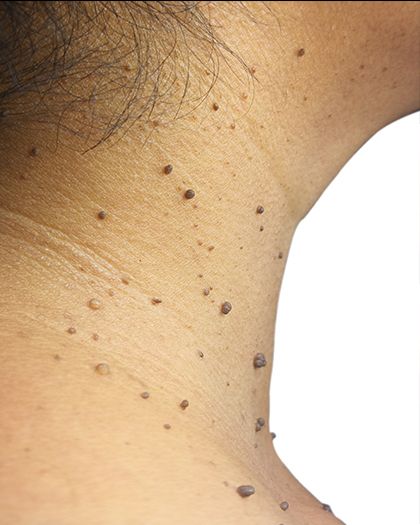Skin tags and moles are common skin growths that many people experience at some point in their lives. While most are harmless, some can pose health risks, especially in countries like Australia, where high UV exposure increases the risk of skin cancer. This article explores whether skin tags and moles are dangerous, when to seek medical attention, and how to manage them safely.
Understanding Skin Tags
What Are Skin Tags?
Skin tags (acrochordons) are small, soft, flesh-colored or slightly darker growths that hang off the skin. They commonly appear in areas where skin rubs against skin or clothing, such as:
- Neck
- Armpits
- Groin
- Eyelids
Are Skin Tags Dangerous?
- Generally harmless: Skin tags are benign (non-cancerous) and do not turn into cancer.
- Potential irritation: They can become painful if twisted, rubbed, or snagged by jewelry/clothing.
- No medical risk: Unless infected or causing discomfort, removal is usually cosmetic.
When to See a Doctor
- If the tag bleeds, changes color, or grows rapidly.
- If you’re unsure whether it’s a skin tag or another type of growth (e.g., wart, mole).

Understanding Moles
What Are Moles?
Moles (nevi) are clusters of pigmented cells (melanocytes). They can be:
- Flat or raised
- Brown, black, pink, or skin-colored
- Present at birth or develop over time
Are Moles Dangerous?
Most moles are harmless, but some can develop into melanoma, a serious type of skin cancer. Australia has one of the highest rates of melanoma due to intense UV exposure.
ABCDE Warning Signs for Dangerous Moles
A – Asymmetry
- Safe mole: Symmetrical (both halves match if folded in half)
- Warning sign: One half looks different from the other half
B – Border
- Safe mole: Smooth, even edges
- Warning sign: Irregular, blurry or jagged borders that look uneven
C – Color
- Safe mole: Uniform color (single shade of brown/tan)
- Warning sign: Multiple colors (black, brown, tan, red, white or blue) or uneven color distribution
D – Diameter
- Safe mole: Typically smaller than 6mm (pencil eraser size)
- Warning sign: Larger than 6mm or growing in size (though some melanomas can be smaller)
E – Evolution
- Safe mole: Stays relatively unchanged over time
- Warning sign: Any changes in size, shape, color, elevation, or new symptoms (itching, bleeding, crusting)
Additional warning signs include:
- A mole that looks different from all your others (“ugly duckling” sign)
- A spot that won’t heal or keeps scabbing
- Spread of pigment beyond the mole’s border
- Pain, tenderness or itching in a mole
Remember: In Australia’s high UV environment, any changing mole should be checked by a doctor immediately, even if it doesn’t perfectly match the ABCDE criteria. Early detection is crucial for successful melanoma treatment.
When to See a Doctor
- A new mole appears after age 30.
- An existing mole changes in size, color, or texture.
- A mole itches, bleeds, or becomes painful.
Skin Tags vs. Moles: Key Differences
|
| Appearance
Color
Texture
Cancer Risk
Common Locations
Development
Removal Considerations
Sun Connection
|

Risk Factors in Australia
Australia has extreme UV levels, increasing skin cancer risks. Key factors:
- High UV index: Sun exposure damages skin cells.
- Fair skin: Less melanin increases vulnerability.
- Family history: Genetics play a role in melanoma risk.
Prevention Tips
- Use SPF 50+ sunscreen daily.
- Wear hats, sunglasses, and protective clothing.
- Avoid sun exposure between 10 AM–3 PM.
- Get annual skin checks with a dermatologist.
Removal Options in Australia
Skin Tag Removal
- Cryotherapy (freezing with liquid nitrogen)
- Cauterization (burning off)
- Surgical removal (scissors/scalpel)
- Ligation (tying off blood supply)
Does Medicare cover it?
- Only if medically necessary (e.g., irritation, infection).
- Cosmetic removal is usually out-of-pocket (50–50–200 per tag).
Mole Removal
- Shave excision (for raised moles)
- Punch biopsy (for deeper moles)
- Surgical excision (if cancer is suspected)
Does Medicare cover it?
- Yes, if the mole is suspicious (Medicare rebate applies).
- Cosmetic removal may cost 200–200–500 per mole.
Myths vs. Facts
❌ Myth: Cutting off a skin tag at home is safe.
✅ Fact: DIY removal can cause infection—see a professional.
❌ Myth: Only dark moles are dangerous.
✅ Fact: Even pink/red moles can be cancerous.
❌ Myth: Skin tags can turn into cancer.
✅ Fact: They are always benign.
When to Worry: Emergency Signs
Seek immediate medical help if:
- A mole bleeds without injury.
- A skin growth rapidly changes in size/color.
- You notice multiple new moles appearing suddenly.
At Medix Clinic, we offer a comprehensive range of skin and cosmetic treatments tailored to your needs. Our services include acne scarring in Melbourne, scar treatment in Melbourne, and radio frequency microneedling in Melbourne to promote skin repair and regeneration. We also provide professional skin needling in Melbourne, advanced skin tightening in Melbourne, and effective skin tag and mole removal in Melbourne. For pigmentation issues, we offer targeted pigmentation removal in Melbourne, and to restore your skin’s glow, we specialise in skin rejuvenation in Melbourne. Additionally, you can enhance your smile with our safe and effective LED teeth whitening in Melbourne
